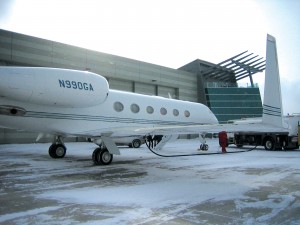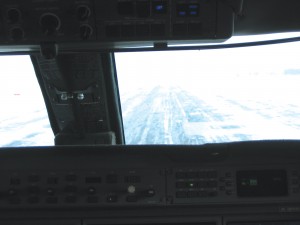By Robert P. Olislagers,
Seven degrees below zero—that’s how cold it was on February 16, the morning Gulfstream was scheduled to set a new city-pair world speed record from Centennial Airport (APA) in Denver, to Hawaii’s Honolulu International Airport (HNL) in a new G-450. Larry Mueller and Craig “Skip” Wilkerson, senior international captains with Gulfstream, were undaunted by the swirling snow and frigid-cold temperatures as they waited for a Denver jetCenter employee to finish uploading a few thousand pounds of Jet-A.
As they lined up for takeoff from 35R, both were confident about the mission; despite strong headwinds, the veteran flyers touched down seven hours and seven minutes later on Runway 04R at Oahu’s Honolulu airport, to set a new record in its class (pending NAA/FAI verification). Of course it was a bit warmer—reportedly 77 degrees and sunny—lucky sevens!
On board were the flight crew and sales representatives from Gulfstream, a General Dynamics Company, eager to demonstrate how fast their state-of-the-art aircraft would handle long distance flight, converting fuel into time saved. In the jump seat was yours truly, cleared to go along as ballast–in hand, the cheapest available online one-way ticket back to Denver on a smoker, literally hours after touching down.
Of course, going from a gleaming G-450 to a tired looking 757 on a bankrupt airline is the ultimate reality check. From a pristine glass flight deck, not to mention an exquisite cabin, to those comfy airline seats in the back of an overcrowded tube of hacking tourists and screaming kids, having to pay for an in-flight meal not much better than when they were free—serious downer! But the G-450 was on its way to the Singapore Airshow and this was the end of the line for me, the frozen tundra beckoning where outside temperatures that night would set yet another record.low, minus 13. Brrrrrr! No complaints, though. How often do you get to be part of history on such a magnificent bird?
City-pair records are unique and often demonstrate an aircraft’s capability and Gulfstream has an obvious winner in the G-450. This isn’t just a re-tooled G-IV/SP but a sleek-looking aircraft with a larger, comfortably quiet stand-up cabin equipped with all the amenities modern biz-jets must have to support execs and management teams engaged in global competitive endeavor. The cockpit is roomier too and the avionics suite, including HUD and EVS, are state of the art. More importantly, it gets you there fast, not just in short bursts of speed but sustained performance in the high Mach regimes. The twin Rolls Royce engines produce well over 25,000 pounds of thrust, which was very noticeable on takeoff. Yet, as powerful as the engines are, they are also exceptionally fuel efficient, allowing this trip of over 2,900 nm to be made well within its 4,350 nm range.
Prior to takeoff, Rich, Jeff and John at the Phantom Hangar had everything in tiptop shape for the scheduled departure around 0900L, their hospitality and dedication always first-cabin. The award-winning snow crew at Centennial Airport had already been hard at work since 0200L that morning, but Lorie, David and company plowed the runway one more time, finishing in time for a go-for-throttle at the appointed hour.
Thanks to APA ATCT and Denver Center staff, the crew was able to climb straight to FL230. Leveling off, it became clear that weather wasn’t going to cooperate. The aircraft flew effortlessly but the instruments told another story—headwinds! For the last two weeks headwinds had averaged no more than 30 kts and flight planning called for a flight of about 6 hours and 30 minutes, but not this day.
Final flight planning indicated headwinds twice what was initially projected—not unusual this time of year. But out of the gate, headwinds were greater still and only subsided slightly as the aircraft got closer to the former Sandwich Islands. When it was all said and done, headwinds averaged more than 60 kts over the entire 2,900 + nm course. Yet in spite of the winds aloft, the flight was smooth; especially on top at FL400, where the horizon curved ever so gently, this flight looked more like a Sir Branson space flight than a super cruise over the Pacific.
Captain Larry Mueller, a veteran Marine Corps F-4 Phantom driver and Captain Skip Wilkerson, an Air Force F-16 Red Flag pilot in another life, methodically navigated the aircraft towards their destination. Scanning the TV-like instrumentation panels and occasionally checking the HUD, they calculated the best route by trading direction, altitude, speed and even a little fuel as if they were on a bicycle—no problemo!
The FMS blinked the colors of the rainbow, bars indicating altitude and speed; TCAS ever vigilant and look-alike analog gauges making you think you were flying a Connie—Not! If you ever wondered what a dog watching TV is thinking, you will know what went through my head staring at the glass panel before me. It didn’t take long to get a good sense of the Honeywell instrumentation, however, which is almost intuitive. Switching panels required a little more than just osmosis and I was glad they were flying and conducting the tutorial while I watched.
In between explaining the various capabilities of the FMS, I discovered how small the aviation world really is. Turns out the person who cleared me to go on the flight was none other than Randy Gaston, SVP for Flight Operations at Gulfstream and a former B-1 test pilot at Edwards AFB. I had met Randy years ago at Edwards when his father-in-law, Dan Sabovich, introduced us. Dan, who sadly passed away a year ago, almost to the day of the flight, was the founder and long-time airport manager of Mojave Airport and my mentor in airport management! A quick sat call to Savannah confirmed we had not talked to each other in probably 15 years. Small world!
As the aircraft got closer to Hawaii, the crew checked in with Center and they immediately asked how the flight was going. That was a good sign, as they had us on their figurative radar screen as well. Finally, with the runway at PHNL in sight and setting up for landing, Captain Wilkerson made one final request of ATC: “Would you please record our time of landing—Thanks!”
Once cleared to land, the two captains worked in unison to bring the aircraft to a smooth touchdown and a new city pair record was set. Following a quick exit off the runway, it was on to Bradley Aviation on the GA side of the airport and engines shut down. Finally, handshakes and congrats all around! Of course, the line staff at Bradley greeted us with aloha— traditional leis and a cold glass of guava juice. Life is good!
Robert Olislagers is executive director of Centennial Airport and the author of “Fields of Flying,” a book about the history of airports with a foreword by General Chuck Yeager.















